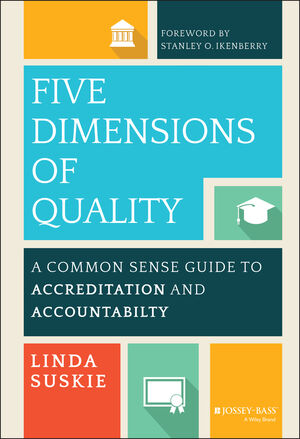Five Dimensions of Quality: A Common Sense Guide to Accreditation and AccountabilityISBN: 978-1-118-76157-1
320 pages
December 2014, Jossey-Bass
|
Description
Author Linda Suskie is internationally recognized for her work in higher education assessment, and she is a former vice president of a major regional accreditor. In Five Dimensions of Quality: A Common Sense Guide to Accreditation and Accountability in Higher Education she provides a simple, straightforward model for understanding and meeting the calls for increased quality in higher education ever-present in today's culture. Whether your institution is seeking accreditation or not, the five dimensions she outlines will help you to identify ways to improve institutional quality and demonstrate that quality to constituents.
For those wading through the accreditation process, which has become more difficult in recent years due to increasing regulation and pressure for greater accountability, Suskie offers expert guidance on understanding the underlying principles of the expectations of accrediting bodies. Using the model presented here, which is much easier to understand than the sometimes complex resources provided by individual accrediting bodies, American colleges and universities can understand what they need to do to earn and maintain their regional accreditation as well as improve overall institutional quality for their students. You'll be able to:
- Identify ways to improve institutional quality
- Demonstrate the quality of your institution to internal and external constituents
- Avoid wasting time and energy on misguided institutional processes to comply with accreditation requirements
By focusing on why colleges and universities should take particular actions rather than only on what those actions should be, Five Dimensions of Quality gives them the knowledge and strategies to prepare for a successful review. It is an ideal resource for leaders, accreditation committee members, and everyone on campus.
Table of Contents
List of Tables and Exhibits ix
List of Jargon Alerts xi
List of Acronyms xv
Foreword xix
Preface xxv
Acknowledgments xxxi
About the Author xxxiii
Introduction: Today’s Quality Context 1
1. Why is American Higher Education Under Fire? 3
2. Understanding American Accreditation 11
3. Quality: Committing to Excellence 25
4. Why is This So Hard? 35
Dimension I: A Culture of Relevance 49
5. Integrity: Doing the Right Thing 51
6. Stewardship: Ensuring and Deploying Resources Responsibly 59
Dimension II: A Culture of Community 75
7. A Community of People 77
8. Leadership Capacity and Commitment 89
Dimension III: A Culture of Focus and Aspiration 97
9. Purpose: Who Are You? Why Do You Exist? 99
10. Goals and Plans: Where Are You Going? How Will You Get There? 107
11. Who is a Successful Student? 119
12. Helping Students Learn and Succeed 129
Dimension IV: A Culture of Evidence 145
13. Gauging Success 147
14. Good Evidence is Useful 161
15. Setting and Justifying Targets for Success 167
16. Transparency: Sharing Evidence Clearly and Readily 177
Dimension V: A Culture of Betterment 189
17. Using Evidence to Ensure and Advance Quality and Effectiveness 191
18. Sustaining a Culture of Betterment 197
Conclusion: Integrating and Advancing the Five Dimensions of Quality 209
19. Demonstrating Quality to Accreditors 211
20. Program Reviews: Drilling Down into Programs and Services 229
21. Where Do We Go from Here? A Six-Point Agenda for Ensuring and Advancing Quality 239
References 249
Index 265
Author Information
LINDA SUSKIE is a bestselling author, speaker, trainer, and consultant on assessment and accreditation in higher education. She has served as vice president of the Middle States Commission on Higher Education, associate vice president for assessment and institutional research at Towson University, and director of the Assessment Forum of the American Association for Higher Education. She is the author of Assessing Student Learning from Jossey-Bass.
Press Release
Connect with Wiley Publicity
Accreditation is a topic of interest to every college and university, yet there is general confusion across all sectors of American higher education regarding regional accreditors' expectations. Most actions taken by regional accreditors require some follow-up, and in response to increasing regulation and calls for greater public accountability, accreditors' expectations have been steadily increasing. Both trends suggest that institutions could benefit from clearer guidance on what accreditors are looking for.
For those wading through the accreditation process, Five Dimensions of Quality: A Common Sense Guide to Accreditation and Accountability (Jossey-Bass, a Wiley brand; October 2014; $45.00) offers expert guidance on understanding the underlying principles of the expectations of accrediting bodies. Using the model presented in the book, American colleges and universities can understand what they need to do to earn and maintain their regional accreditation as well as improve overall institutional quality for their students.
By focusing on why colleges and universities should take particular actions as well as on what those actions should be, Five Dimensions of Quality: A Common Sense Guide to Accreditation and Accountability gives leaders, accreditation committee members and everyone on campus the knowledge and strategies to prepare for a successful review.











